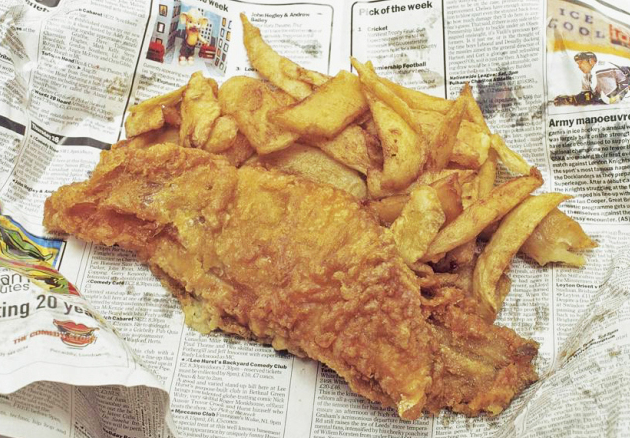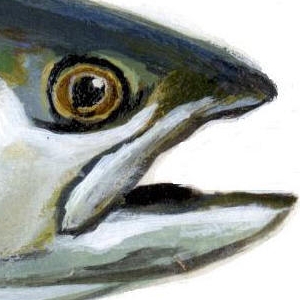I just came across a fascinating article comparing the healthiness of various types of fish. I liked it’s fresh approach – focusing on the positive, not the negative. But its conclusion left me feeling… sheepish. Because it served me up a surprise!
 Classic British Fish and Chips: Not as cheap as it used to be. And both the fish and
Classic British Fish and Chips: Not as cheap as it used to be. And both the fish and
the chips are deep fried. But it remains a healthy option – packed with protein
and vitamins – if you limit your consumption to once a week or so…
Not your usual ‘fish’ post
I was expecting the usual post ranking fish by their respective unhealthiness. These repetitive rundowns usually list fish from fresh to canned, from lean to oily, or from ‘clean’ to most mercury-contaminated.
But I’ve never before seen a comparison based on the positive side: actual nutrition facts. And that’s what drew my attention to the post in question.
Numbers don’t lie
The numbers, based on known official nutrition facts listings, were an obvious basis on which to rank the healthiness of various types of fish. And the result was surprising, on a number of levels.
And the winner is…
Sardines!
You heard it here first. In fact, I lauded sardines as a superfood in a previous post where I enumerated their many healthful ‘ingredients’. Chief among those is a large dose of Omega-3 fatty acids, billed as helpful in fending off diabetes, heart disease and some cancers. Sardines are also a powerhouse source of calcium, magnesium and iron – all important for bone strength. Overall, one 3.5 oz. / 90 g can delivers significant amounts of 13 important vitamins and minerals.
Add to that, sardines are relatively cheap, self-sustaining in the wild, and have an indefinite shelf life (in sealed cans).
Too bad they taste the way they do. The epitome of ‘fishiness’. And that factor alone has traditionally turned many folks away from these otherwise excellent morsels…
Salmon
… Came in a distant second after sardines. This fishy family – which includes trout and Arctic char – shares many of the same nutritional components with sardines (in lesser quantities) but is less fishy tasting. So, it’s naturally more attractive to more diners. Salmon are found in relative abundance in the rivers and along the coasts of Northern North America, and the British isles.
Drawbacks? They’re an oily fish, but there are your yummy Omega-3s! Alas, salmon is among the more expensive fish you can buy.
Heavy metals? Like sardines, salmon doesn’t retain and concentrate heavy metals such as mercury and cadmium. To me, that’s worth the extra cost!
Halibut
… Is surprisingly rich in essential nutrients, offers a distinctive, mild, non-fishy flavour, and features a beautiful, flaky texture. Of special note, it can provide up to 50 percent of your daily recommended dose of vitamin B12, which is important to a whole array of metabolistic and digestive functions. It’s a traditional favourite among Fish and Chips aficionados.
Drawbacks? Like other open-sea fish, it does absorb heavy metals. Older, larger specimens are not recommended for human consumption. And though the US Food and Drug Administration (FDA) rates it high among the white fish, it also recommends eating Halibut no more than once a week.
Cod
It’s back! After nearly being fished to extinction in the latter half of the last century. And it ranks among the highest-protein salt-water fish. It’s also high in B vitamins, which are important for so many reasons.
Cod was – and is – so popular partly because it boasts a creamy mild flavour and a texture than can stand up to frying, grilling, baking, or even simmering in a soup or stew. In addition, it doesn’t post a risk vis-à-vis heavy metal contamination.
It’s not as cheap as it used to be, but it’s a great all-purpose fish choice.
Tuna
Bringing up the rear of the ‘recommended’ fish species, tuna has a reputation as being high in mercury.The older and larger the fish, the more heavy metal it will have absorbed.
But it remains endorsed by the FDA as one of the most nutritious species you can eat. And one of the cheapest. It’s high in Omega-3s, selenium, iron and vitamin B12.
Alas, tuna is often regarded as suspect in its provenance. Popular wisdom holds that ‘tuna’ – particularly canned – is often adulterated, or substituted with other inferior species. Particularly maddening to animal rights activists is the finding that some brands of canned tuna actually contain porpoise and dolphin meat…
My take
Yes, fish has lately been burdened with a reputation as ‘too expensive’. In its defense, I offer the observation that fish is a concentrated source of protein and other vital nutrients, and it’s famously low in calories.
Fresh fish may be priced out of reach for you, but canned tuna is still a realistic option. The experts say Albacore is your best value. And stick with the big-name brands to make sure you’re really getting what it says on the label…
~ Maggie J.

